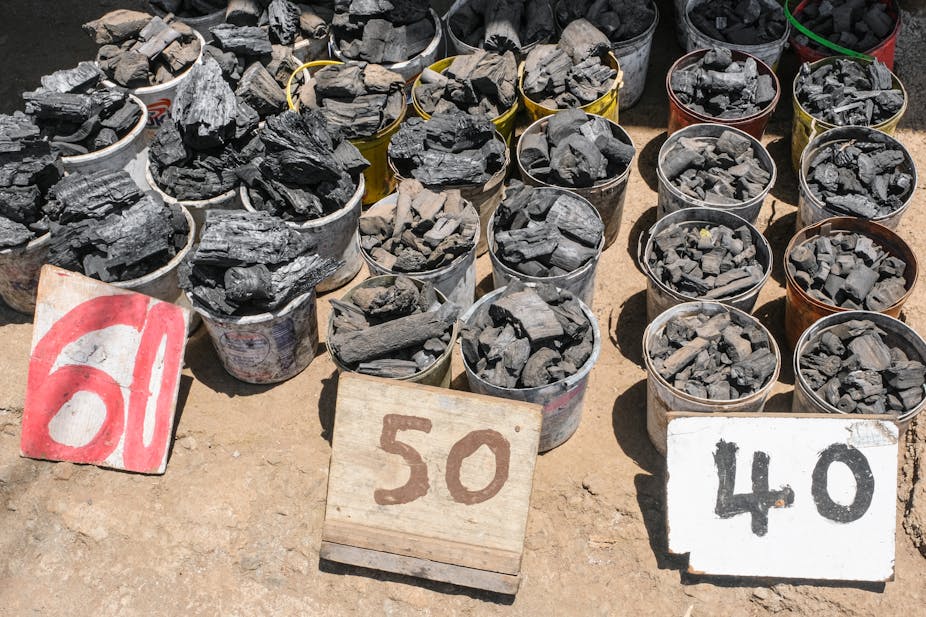In Kenya, charcoal has met more than 70% of the domestic energy demand for cooking and heating over decades, and is a major source of livelihood for hundreds of thousands of people in rural areas.
Charcoal is produced by burning wood under limited supply of oxygen, a process known as carbonisation. This carbon rich product is produced in kilns. Most kilns used in Kenya – and Africa in general – are very inefficient. Almost 10 tonnes of wood are used to produce a tonne of charcoal, which is a 10% recovery rate. More modern and improved techniques and kilns – of various quality and cost – are being developed and promoted with recovery rates of more than 30%.
Most of this production takes place in forest rich rural areas. The charcoal is then transported to urban centres where it is sold to wholesalers, who then sell to retailers and vendors, who in turn sell to consumers in smaller quantities.
Pricing of charcoal is very location dependent. But it can cost up to US$23 per bag in Nairobi and most cities. Vendors sell in much smaller quantities – as small as 2kg packets.
Over the past 20 years, Kenya developed laws and policies with the hope of bringing the sector into the formal economy and reducing its environmental impacts. This was after rampant destruction of forests and a realisation that what is not known cannot be regulated.
In 2018 the government imposed yet another ban on logging and timber harvesting, which is due to end this year. This ultimately prohibited production or transportation of charcoal in the country. This was followed by charcoal bans in some counties. In addition, inter-county transportation of charcoal was outlawed, though production for local use remained legal. Still, charcoal found its way to cities where demand is rising and there are no appropriate alternative options.
Thus the production and consumption of charcoal has continued. With limited enforcement capacity and compliance, it is clear wood fuel governance needs to be fundamentally rethought.
In our recent study we analysed the governance of Kenya’s wood fuel sector to identify the bottlenecks, and highlight the critical aspects that need to be addressed to make it work for people and the environment.
Our main findings were that there was limited coordination and cooperation between various parties charged with managing the sector. And the counties have limited capacity to deliver on all the devolved functions and responsibilities.
Demand for charcoal and firewood in Kenya is set to increase, while its tree cover continues to dwindle. Decision-makers at national and county level must urgently improve governance of the sector.
Regulating charcoal
In Kenya, a variety of agencies oversee charcoal and firewood resources. Their job is to control, support and guide wood fuel production and use. They span the environment, forestry, agriculture and energy sectors at both national and subnational levels.
Unfortunately, mandates overlap and the activities of the various departments and bodies are only loosely coordinated.
A case in point is wood fuel production in Baringo and Kitui counties. Baringo is located in arid and semiarid lands of the Rift Valley region. Kitui lies 160km east of the capital Nairobi and was one of the major suppliers of charcoal to big cities until the ban in 2018.
According to the survey respondents, who included regulators, service providers, charcoal producers and traders, there are as many as 16 organisations tasked with monitoring wood fuel use in both counties.
This leads to duplication, confusion and even gaps.
This is complicated by the periodic charcoal bans which make it illegal to commercially produce and transport charcoal, but perfectly legal to sell and use it.
Another major bottleneck is capacity constraints at county level. Since their formation in 2013, county governments have made commendable attempts to develop specific charcoal strategies and implement them with the support of the Kenya Forestry Service and agencies. But this has been hampered by delays in the transition of responsibilities from the national government to the local government.
In addition, the authorities at the local level aren’t adequately resourced to take over the functions that used to depend on national agencies. The lack of financial and human resources makes it difficult for counties to enforce rules, support extension services and promote better practices among charcoal producers.
Opportunities and options
The Forest Charcoal Rules 2009 cover the production and distribution of wood fuel. They require commercial producers to register as members of a Charcoal Producer Association and to acquire a harvesting permit and a production licence from the Kenya Forestry Services. Transporters are required to have movement permits and traders are expected to keep records of the sources of their charcoal.
These associations are well positioned to play a key role in connecting producers, traders and brokers. One of the first steps government could take would be to give them the technical, legal and organisational support to be functional and fully operational.
The associations should be given knowledge and skills in sustainable tree harvesting and woodland management and use of improved and efficient kilns.
Producers also need support in improving their financial literacy and marketing skills to increase profit margins. They also need clear incentives to comply with the rules. That is, producing and selling charcoal legally should be facilitated and illegal operations sanctioned.
Kenya – as well as other countries in sub-Saharan Africa – should also strive for well-defined institutional mechanisms and coordination across sectors and especially at county levels as a first step towards better wood fuel governance. Most important of all is the need to deal with illegal dealings in large scale production and trade in the sector.
Finally, one of the top priorities for wood fuel governance should be to support county governments to develop, resource and implement their own strategies and bylaws for wood fuel production, trade and use.

